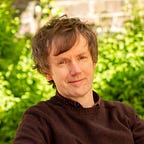Boreholes, bottles and black alder: what will be left of us a million years from now?
What traces of our energy infrastructure will be discernable in the far future?— a review of David Farrier’s Footprints: In Search of Future Fossils
‘The hills are shadows, and they flow/From form to form’ wrote the Victorian poet Alfred Tennyson in his elegy In Memoriam, one of the first works of literature to try to make sense of the world from the vertiginous perspective of deep time opened by the then new science of geology.
Footprints: In Search of Future Fossils by David Farrier, an English lecturer at Edinburgh University, is a fresh effort to use myth, narrative and image to situate the brevity of the human story in the context of an ancient world. Where Tennyson looked for the deep past in the present, Farrier sifts it for signs of the far future, seeking to discern the traces we will leave millions of years from now.
The imprint of the oil and gas industry, for good and ill, is at the heart of his essay. As the writer Ryszard Kapuscinski observed, ‘Oil is a fairy tale’, like all fairy tales promising new freedoms, but at a cost. Farrier considers the industry’s most notorious by-product, atmospheric carbon buildup. But his primary focus is its physical legacy: the infrastructure necessary to get oil out of the ground and transport it, and the electrified urban civilisation it has made possible.
He surveys the oil graveyards of Azerbaijan through the photography of Edward Burtynsky, whose wide-angle shots of skeletal derricks, rig carcasses, ghost refineries and blackened landscapes are the negative image of the shining cities and buzzing road networks constructed and powered by the energy they produce.
But long after those surface structures have weathered and worn away it is the boreholes sunk into the Earth that will remain. Laid end to end, they would make a borehole some 50 million kilometres deep, equivalent to the planet’s entire paved road system. They go far deeper than holes dug by any other life form: the Kola Superdeep Borehole drilled by the Soviets pokes more than 12 kilometres underground, far below the silent depths inhabited by the most hardy microbial communities. Some will still be there more than a million years from now, when the great motorways and cities will survive only as asphalt and concrete stratum a few metres high. Curiously it is the low-lying megacities most vulnerable to rising seas, like Mumbai, Guangzhou and Kolkata, that will leave the deepest trace, their foundations, metro lines, pipes and cables caulked by thick layers of mud, shielded from corrosive wind, rain and sun.
Farrier finds a vivid example of the Earth’s embalming power close to home, in the new Queensferry Crossing over the Firth of Forth, ‘a miracle of light and air’ seemingly held fast by brilliant white threads strung from three spindling towers. In fact this ethereal structure is secured by a massive bolus at its southern end created by the longest ever continuous underwater pour of concrete, 17,000 cubic metres tipped night and day for weeks into the rock below the river. A million years from now, when the bridge’s elegant towers and 37,000 kilometres of cables are long gone the bolus is all that will survive, as Farrier puts it, ‘written into the earth like speech marks around a lost quotation, bearing witness that here, once upon a time, a road crossed a river that will itself long since have vanished.’
Elsewhere he charts the Homeric journey of one of oil’s most ubiquitous products, the plastic bottle. His bottle begins life as algal bloom, and after a glacial 150 million years transmutation into oil, its slumber is suddenly disturbed when the borehole finds out its layer. Within a matter of weeks it becomes plastic, is shaped as a bottle, and lives a brief life in the light before being casually discarded into a river and swept out to sea. It is pulled across the oceans by currents and anticyclonic winds to the 20 million square kilometre expanse of the North Pacific gyre, where more than five trillion individual pieces of plastic accumulate into trash islands. After more than 350 years, tossed by passing ships, pecked by gulls, and nibbled by fish, the bottle finally breaks apart. Its fragments sink to the sea bed and, encased in anoxic sediment layers, slowly return to oil.
Another fascinating vignette contemplates the long, long afterlife of an alternative energy source, uranium. Older than Earth itself, forged in ancient supernovae more than six billion years ago, the element presents challenges of safe disposal that strain the imagination, as demonstrated by the elaborate ‘nuclear semiotics’ designed to protect the Waste Isolation Pilot Plant (WIPP) in New Mexico against disturbance by future generations.
Addressing the concern that words themselves have a half-life — lingusts believe languages last for around 750 to 10,000 years — the system draws on semiotics, anthopology and mythology to design a warning system to resonate across millenia. WIPP will be wreathed with iconography intended to communicate a sense of dread, and even fear of supernatural retribution, comprising jagged rocks, claustrophic tunnel architecture, and images of revulsion modelled on Edvard Munch’s The Scream. It’s all quite different from the approach taken at Finland’s Olkiluoto repository, where the waste is simply buried in copper canisters deep in the ancient bedrock and allowed to slumber under forests of of black alder, forever.
Farrier’s essay ends with a question asked by Italo Calvino in his novel Invisible Cities: ‘If a New World were discovered now, would we be able to see it?’ Footprints helps us make out that distant world at the edge of vision, ‘by the eerie light cast by the onrushing future.’
Footprints: In Search of Future Fossils by David Farrier is published by 4th Estate. This review first appeared in the March/April 2020 edition of the SPE London Review.
